
No doubt about it. Cereal giant Kellogg’s was heavily into television advertising. They sponsored an unwholesome number of programs, and that included many cartoon shows.
In the fall of 1957, The Woody Woodpecker Show premiered on ABC television. It was made up of older theatrical cartoons along with new bumpers and interstitials. Kellogg’s was the sponsor, and as was the custom in them days, the star of the show could be seen plugging the sponsor’s wares.
For me and probably a lot of other kids, it was a thrill to see Walter Lantz giving lessons about how cartoons were made. Director Alex Lovy was often shown in these sequences, and it’s my guess that they used him because he could draw with both hands. That meant that he could be photographed drawing from either side!
By my memory, the last network showings were on NBC in the ’76 -’77 season. They would show two Woody cartoons with an Andy Panda cartoon in the middle. Weirdly enough the fifties and sixties shorts were more heavily censored that the forties ones. Lantz must’ve been disgusted with the network meddling, because shortly afterwards he put out a large syndication package that included most of his color cartoons, uncut and with titles and credits intact (some of the local stations may have done some of their own editing unfortunately.) It was great until Lantz sold everything to Universal in the mid eighties.
By the time of the network TV show, Grace Stafford (Walter Lantz’s spouse) had been established as the regular voice of Woody, and she can be heard in all of the following commercials.
Market
This and the following three spots were likely produced in the early years of the Woody Woodpecker network show. This one was animated by Don Patterson (except for the shot of Woody eating the cereal, which was re-used from another spot animated by Laverne Harding.) Don was one of the real greats in the cartoon business. He’d worked for Mintz, Disney, and MGM before moving to Lantz in the early fifties. He was originally hired to animated for Walter Lantz himself, before Lantz put Don in the director’s chair. As a director, Don made cartoons that were very unique and funny. He was bumped back into animating when Tex Avery briefly returned to the studio. Don did brilliant animation for Tex, as well as Alex Lovy and Paul Smith before moving to Hanna-Barbera where he spent the rest of his career. Dallas McKennon is the voice of Crackle.
Moose
Animation by Laverne Harding. She had been with Walter Lantz for many years before moving to Hanna-Barbera. From there she went to DePatie-Freleng where she animated on many of the early Pink Panther cartoons. When Warner Bros. re-activated their cartoon studio, Harding was one of the artists they pinched from DFE.
Bear Hunt
Woody with a hunting rifle? More animation from Laverne Harding.
Rice Krispies Treats
Art Gilmore narrates. Animation by Ray Abrams. Abrams worked for Lantz in the thirties before moving to the newly formed MGM studio. He worked on The Captain and the Kids cartoons before becoming a fixture in Tex Avery’s unit. Abrams moved back to Lantz when he was resuming production of shorts in the early fifties.
Buzzard Bucks
I’m guessing this was made about 1967. Les Kline animates. He’d spent most of his career working for Lantz. June Foray is Knothead and Dallas McKennon is Buzz.
Breakfast on a Train
This spot is probably from 1972, and things are starting to look sad here. The Lantz studio was about to cease production of shorts. Director Paul Smith was about to retire. The animators here are two refugees from Disney, Volus Jones and Al Coe, both men spent measurable time drawing Donald Duck. Coe had been with Disney and moved to Lantz along with Jack Hannah to work on the TV show (He’d animated the famous “Meet my boss, Walter Lantz!” opening) then moved into shorts with the departure of Alex Lovy, Don Patterson and Laverne Harding. Volus Jones went from Disney to Format Films, DePatie-Freleng, the new Warner Bros. studio, Hanna-Barbera, and finally Lantz. Jones did the scenes in the train, and Coe did the exterior shots. Shep Menkin is the voice of the conductor.


 Mike Kazaleh is a cartoonist and animator whose work can be seen in comic books like Bongo’s The Simpsons, Futurama and Papercutz’ Gumby – and on screen in Warner Bros. Tiny Toon Adventures, Ralph Bakshi’s Mighty Mouse: The New Adventures and Cool World.
Mike Kazaleh is a cartoonist and animator whose work can be seen in comic books like Bongo’s The Simpsons, Futurama and Papercutz’ Gumby – and on screen in Warner Bros. Tiny Toon Adventures, Ralph Bakshi’s Mighty Mouse: The New Adventures and Cool World.


































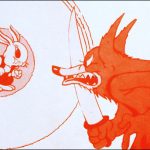
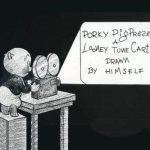
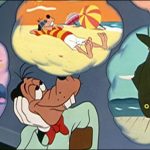

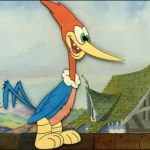
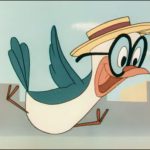
















Mike,these were very entertaining spots and well done,too.Even the last one.The studio may have been ready to close up shop,but since it was the only show left in town at that time,I still found it enjoyable!
Honestly, why did Lantz thought it was good idea to have Smith to be the sole director of Lantz during the studio’s final years? He gave a bad name for the studio. Couldn’t Lantz himself do the directing instead? I thougt he did a good/decent job directing. Besides, he could’ve saved money in direction cost.
You would think. It would not have seen like a bad idea if he felt he was still qualified to direct at that point in his life. I’m sure he’d have enough support on staff to make it work.
Wow….these are terriff. Thank YOU! I remember the late-50s Lantz show like it was ystdy! Yes, i totally agree : 70s Lantz is unthinkably bad (but still not as bad as 60s Popeyes, lol)
You can tell why H-B pinched Patterson and Harding—really expressive, lively work accomplished with few drawings. The Les Kline spot kind of epitomizes why the later Lantz work has a rep for bad artwork, even if it’s funny. Thanks for the roundup, had only seen two of these before.
Very entertaining and informative. Mike, you are dead-on the animation ID’s and the animator backgrounds and Lantz history. I share your opinions on most of the Lantz and animator comments.
As for the commercials themselves, they’re quite entertaining. The Patterson one was the best animated, I thought. I’m guessing Alex Lovy directed the 50’s commercials since they mainly used animators from his unit. Anyway, thanks for this. As a Lantz nut, it was great for me to discover!
One of the things I never liked about later Woody was Grace Stafford’s voice for the character. Since I’ve never met anyone else who felt the same way, I’ve long since written that off to some peculiarity in my make up. Her Woody voice grates on me, though, in the same way that voices for children do when provided by adult women who try to imitate a child by speaking in a very high-pitched, sing-song falsetto.
I guess I was too use to the voice myself. Having once had a talking Woody Woodpecker doll I kept pulling the string to to hear ‘her’ say those famous lines.
I find it interesting that Kellogg’s cereals promoted animated characters from competing studios at the same time (Hanna-Barbera and Lantz-Universal). Kellogg’s redesigned their entire line of cereal boxes for 1967 (I suspect the H-B contract was ending, so they needed new characters). The Knothead-Buzzard Bucks commercial predates the box redesign, as the new box featured Snap, Crackle and Pop together on the side of the cereal bowl.
That’s how I first saw them in the early 80’s courtesy of WKBD-TV in Detroit, who never edited out the credits or anything on their prints thankfully (they did so on the Harvey Films stuff for some reason and of course the Warner Bros. stuff often had a minute’s worth of the cartoon trimmed after the credits to fit in more ad time no doubt, I recall they could fit 4 per half hour that way). The only trade-off I suppose is not getting to see ol’ Lantz tell me how they did it or to see Lovy’s excellent draftsmanship with both hands. I would’ve loved to have seen that had it been spliced in before each cartoon began.
That was a bummer, but I guess it couldn’t last forever. Never cared for who it was presented from ’87 onward, or not seeing the Walter Lantz Prods. copyright on merchandise, but that’s just me (I never associated Woody Woodpecker with Universal for such a long time, I wasn’t sure why that is but thinking back, I don’t remember WKBD ever showed the Universal logos on their prints of the cartoon, either they were edited out or they cued them up on purpose to start at the main title card).
I saw the Lantz cartoons around that time via cable from KMSP-TV in Minneapolis. They ran them in a half-hour package with 3 or 4 cartoons (can’t remember now) and the “Woody Woodpecker Show” open and close. Their editing of all the cartoons except the first one consisted of lopping off the main title AND whatever amount of action led up to the point where the toon would fit the time slot. It wouldn’t have been so bad had they run the cartoons in set programs (and used some sense in editing; the 70’s Lantzes are only about 5:45 each and would have fit well timewise with longer older cartoons.) But no; they ran them in random assortments and cut and spliced them differently each time, so the prints grew splicier and scratchier with each handling. After a couple years, they looked like school-film rentals.
The later pre-packaged Woody show was no prize either, with dull color, soft-looking transfers, and weirdly arbitrary editing. (Not to mention the badly done new opening by Format Films, and an off-kilter recreation of the Lantz logo that seemed to put “Walter” and “Lantz” on two different planes…
I am trying to complete my classic Woody Woodpecker cartoon collection, period 1963-72 and need some episodes (VHS copies, poor quality: no problem). Any answer would be greatly appreciated. Thanks for your time.